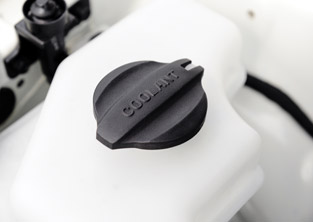
Freezing Point of Aqueous Engine Coolants
Antifreeze/engine coolant is an essential fluid used in internal combustion engines to remove excess heat, prevent overheating and control engine operating temperatures. Additionally, AF/C engine coolant provides freeze, boil-over and corrosion protection for all engine and cooling system metals.
An important ASTM engine coolant standard, D3321, Test Method for Use of the Refractometer for Field Test Determination of the Freezing Point of Aqueous Engine Coolants, has recently been revised to reflect advances in engine coolant technology used in modern engines.
D3321 is under the jurisdiction of Subcommittee D15.03 on Physical Properties, part of ASTM International Committee D15 on Engine Coolants and Related Fluids. D3321 is used to provide a freeze point determination of ethylene glycol and propylene glycol based engine coolants based on correlation of refractive index and EG or PG concentration in water. This test is widely used in the industry to ensure that antifreeze/coolant solutions provide satisfactory freeze protection and prevention of engine/cooling system component damage under low ambient temperatures.
According to Fred Alverson, principal engineer, Shell Global Solutions and a D15 member, the nature of technological advancements in engines has increased the number of engine and cooling system components requiring protection (for example, EGR coolers, CAB brazed aluminum radiators, water pumps and housings, turbochargers, and inner coolers, etc.). In addition, engine operating conditions have become more severe, including higher coolant temperatures, greater metal skin temperatures/heat fluxes and higher coolant flow rates.
Alverson says all of this change led to concerns that newer extended life coolants containing high levels of carboxylate corrosion inhibitors could affect the refractive index correlation with freeze point, thus requiring new refractometer freeze point scales.
An interlaboratory study was conducted at nine laboratories using D3321. Results showed minor variations in the freeze point between different types of coolant chemistries and different brands and models of refractometers.
"However, the current field refractometers are considered suitable for monitoring and maintaining freeze protection in the field within a few degrees," says Alverson. "If a refractometer is used for quality control of incoming receipts or coolant dilution during factory fill, a separate refractometer or scale may be warranted for increased accuracy."
Alverson also notes that the ILS study showed that refractometers should be periodically checked or calibrated with water and a 50/50 coolant to ensure accuracy.
Alverson invites all interested parties to join in the continual evolution of D3321. He notes that the coolant industry is currently investigating and using (to a limited extent) glycerin and propanediol as AF/C base fluids. The subcommittee is currently investigating how to incorporate glycerin and propanediol into future revisions of D3321.
To purchase ASTM standards, visit www.astm.org and search by the standard designation, or contact ASTM Sales (phone: 877-909-ASTM; sales@astm.org).
CONTACT Technical Information: Frederick C. Alverson, Shell Global Solutions • Houston, Texas • Phone: 281-544-9217 | ASTM Staff: Joe Koury • Phone: 610-832-9804 | Upcoming Meeting: May 21-22 • May Committee Week • Indianapolis, Ind.
 SN Home
SN Home Archive
Archive Advertisers
Advertisers Masthead
Masthead RateCard
RateCard Subscribe
Subscribe Email Editor
Email Editor